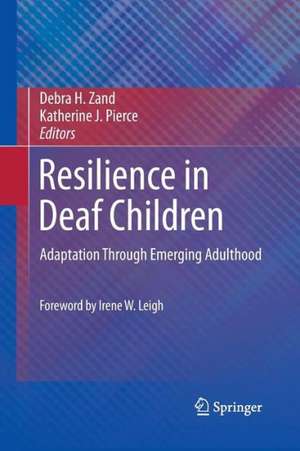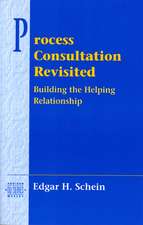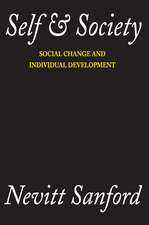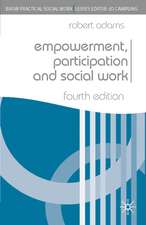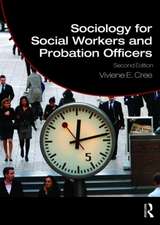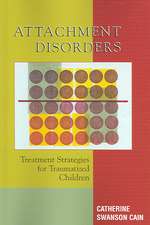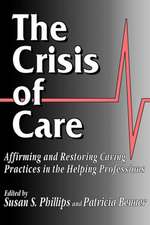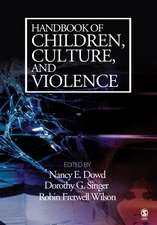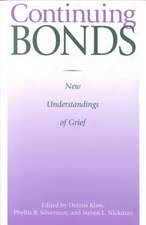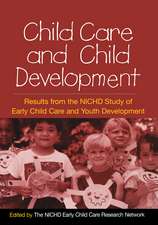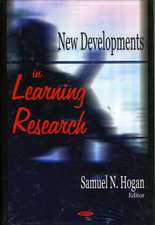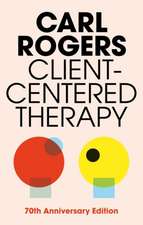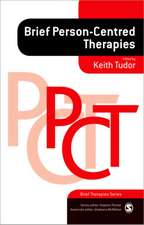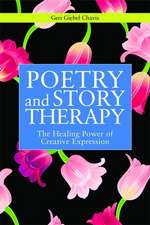Resilience in Deaf Children: Adaptation Through Emerging Adulthood
Editat de Debra H. Zand, Katherine J. Pierceen Limba Engleză Paperback – 7 oct 2014
Resilience in Deaf Children emphasizes not only the capability of deaf individuals to withstand adversity, but also their positive adaptation through interactions with parents, peers, school, and community. In this engaging volume, leading researchers and professionals pay particular attention to such issues as attachment, self-concept, and social competence, which are crucial to the development of all young people. In addition, the volume offers strategies for family members, professionals, and others for promoting the well-being of deaf children and youth.
Coverage includes:
- Attachment formation among deaf infants and their primary caregivers.
- Deaf parents as sources of positive development and resilience for deaf infants.
- Enhancing resilience to mental health disorders in deaf school children.
- Strength-based guidelines for improving the developmental environments of deaf children and youth.
- Community cultural wealth and deaf adolescents’ resilience.
- Self-efficacy in the management of anticipated work-family conflict as a resilience factor among young deaf adults.
| Toate formatele și edițiile | Preț | Express |
|---|---|---|
| Paperback (1) | 794.44 lei 38-44 zile | |
| Springer – 7 oct 2014 | 794.44 lei 38-44 zile | |
| Hardback (1) | 957.62 lei 6-8 săpt. | |
| Springer – mar 2011 | 957.62 lei 6-8 săpt. |
Preț: 794.44 lei
Preț vechi: 1045.32 lei
-24% Nou
Puncte Express: 1192
Preț estimativ în valută:
152.01€ • 158.73$ • 125.53£
152.01€ • 158.73$ • 125.53£
Carte tipărită la comandă
Livrare economică 11-17 aprilie
Preluare comenzi: 021 569.72.76
Specificații
ISBN-13: 9781489991645
ISBN-10: 1489991646
Pagini: 420
Ilustrații: XXI, 396 p.
Dimensiuni: 155 x 235 x 22 mm
Greutate: 0.59 kg
Ediția:2011
Editura: Springer
Colecția Springer
Locul publicării:New York, NY, United States
ISBN-10: 1489991646
Pagini: 420
Ilustrații: XXI, 396 p.
Dimensiuni: 155 x 235 x 22 mm
Greutate: 0.59 kg
Ediția:2011
Editura: Springer
Colecția Springer
Locul publicării:New York, NY, United States
Public țintă
ResearchCuprins
Dedication.- Foreword.- Acknowledgements.- Introduction.- Chapter 1. Critical Issues in the Application of Resilience Frameworks to the Experiences of Deaf Children and Young People.- Infancy & Toddlerhood.- Chapter 2. Attachment Formation Among Deaf Infants and their Primary Caregivers: Is Being Deaf a Risk Factor for Insecure Attachment?.- Chapter 3. Deaf Parents as Sources of Positive Development and Resilience for Deaf Infants.- Chapter 4. Risk and Resiliency of Infants/Toddlers who are Deaf: Assessment and Intervention Issues.- Childhood.- Chapter 5. Developing a Concept of Self and Other: Risk and Protective Factors.- Chapter 6. Risk and Resilience for Social Competence: Deaf Students in General Education Classrooms.- Chapter 7. Enhancing Resilience to Mental Health Disorders in Deaf School Children.- Chapter 8. Promoting Resilience: Suggestions for Families, Professionals and Students.- Adolescence.- Chapter 9. Whose Literacy Is It, Anyway? Strengths Based Guidelines for Transforming the Developmental Environments of Deaf Children and Adolescents.- Chapter 10. Building Resilience in Adolescence: The Influences of Individual, Family, School and Community Perspectives and Practices.- Chapter 11. Community Cultural Wealth and Deaf Adolescents’ Resilience.- Chapter 12. Promoting Resilience in Deaf Adolescents.- Emerging Adulthood.- Chapter 13. Self-Efficacy in the Management of Anticipated Work-Family Conflict as a Resilience Factor Among Young Deaf.- Chapter 14. Psychological Well-Being in Emerging Adults who are Deaf.- Chapter 15. Resiliency and the Emerging Deaf Adult.- Epilogue.
Recenzii
“This book represents a landmark in the science on competence and resilience in individuals and families who navigate the challenges of deafness over the life course, providing an impressive overview of the theory, issues, and evidence on adaptation and development. The volume underscores the benefits and limitations of a resilience framework for integrating and applying the growing knowledge on adaptation in the context of deafness. The maturing science on development and resilience in relation to deafness has the potential to help a wide range of families, educators, practitioners and communities to appreciate and promote diverse pathways to success in life, while at the same time making unique and important contributions to the science of human development.”
Ann S. Masten, Ph.D., Distinguished McKnight University Professor, Institute of Child Development, University of Minnesota
----
"Why deaf children? Why resilience? Applying the increasingly popular resilience-based frameworks (e.g., Walsh, 2003) to a specific group of children, those who are deaf, would appear at first glance to be both obvious and useful. If resilience is important for children who have suffered adverse circumstances, then surely interventions that promote resilience must be important for deaf* children with limited or no access to the world of sound around them. Resilience in Deaf Children: Adaptation Through Emerging Adulthood, edited by Debra Zand and Katherine Pierce, shows that it is not that simple.
As the contributors point out, there is almost nothing prior to this collection that considers the concept of resilience with this group, making this a groundbreaking work. The book is arranged to follow the life course of deaf children and young people through infancy to emerging adulthood. The contributors, both Deaf and hearing, are leading researchers and professionals in the world of deafness.
For readers who themselves know little about childhood deafness, this collection may involve a steep learning curve in the specific issues that arise for the families of the 90 percent of deaf children who are born into hearing families with no previous experience of childhood deafness. Nevertheless, this book is worth the effort. The detailed discussions of deaf children and areas of general interest such as understanding of self, social competence, attachment, and the benefits of cultural capital raise ideas that are transferable across the boundaries of this specialty.
The editors bravely and wisely open the collection with a section of one chapter that highlights the limitations of the concept of resilience. The chapters that follow are then divided into sections tracking the life course of children and young people: Infancy and Toddlerhood, Childhood, Adolescence, and Emerging Adulthood.
The first chapter, by Young, Rogers, Green, and Daniels (colleagues at the University of Manchester) is based on a previously published literature review (Young, Green, & Rogers, 2008). This has clearly had a strong influence on the rest of the contributions, being cited by 11 of the other 14 authors. It is this chapter that sets the tone for the rest of the collection, and the challenges raised are frequently taken up by other authors. So what are these challenges? Among other questions the authors ask the following:
• What do we mean by resilience? Is it inherent traits or acquired skills? Is it adaptability to disadvantageous circumstances or challenges? Is it synonymous with achieving desired outcomes?
• If resilience is a response to risk, how is risk assessed? For example, is being deaf a risk factor, or is it the results of being deaf that create the risk?
• If resilience is achieving successful outcomes in the face of adversity, do we not have first to acknowledge that successful outcomes are socially constructed? Positive outcomes might be entirely different when they are seen from the culturally different perspectives of Deaf and hearing.
• If we accept that the ability to overcome adversity is to be found in the individual, then have we not located the responsibility for adapting with the individual rather than with a disabling and excluding society?
Many of the contributors rise to these and other challenges. Some follow the traditional notion of resilience as overcoming adversity and ask us to consider the specific context of deaf children, most of whom are raised within an entirely hearing, phonocentric world. Thus our attention is drawn to the importance of context and whether the concept of resilience can be transferred unquestioningly, in this instance, from a hearing to a deaf context.
Of particular interest is the idea that adversity is not something to be overcome by the individual but rather is the problem of a society that fails to value diversity, that does not succeed in enabling access for all to the mainstream, and that, by individualizing the problem, prioritizes a medical rather than a social model of what it means to be deaf. The obvious risk/adversity for deaf children is the lack of access to age-appropriate communication. Understanding and being understood are the cornerstones of much of human development, particularly developing a concept of self, self mastery, and theory of mind. Thus several contributors address the importance of communication—in particular, how positive interventions might be undertaken to strengthen and enhance two-way communication.
There is a subtle difference here between identifying deafness as adversity/risk and the results of deafness in a hearing world, that is, lack of access to communication as the adversity/risk. Deliberate intervention that facilitates communication and ensures access to language, signed or spoken, ameliorates potential problems.
Several contributors begin from a strengths-based rather than a deficit-based perspective. For example, Deaf parents are considered as a resource, although deaf parenting does not guarantee successful outcomes for the child (however successful outcomes are defined). Nevertheless, the skills and ways of being deaf modeled by Deaf parents may offer insights for hearing parents in honing their own parenting skills.
This collection as a whole also highlights an additional problem with seeking to understand resilience. As soon as we start to focus on one aspect of interest, for example, strategies for promoting individual success, we are in danger of losing sight of other important aspects of resilience, such as the responsibilities of society to enable resilience. One chapter can cause us to lose sight of the important insights contained in another. If the book teaches us one thing, it is the importance of not losing sight of the bigger picture and not implicitly adopting uncritically one particular understanding of resilience.
All in all, this is an intriguing and enlightening collection, inviting us to reconsider the concept of resilience. For professionals in the field of childhood deafness, this is obviously an invaluable book. However, there is plenty here that will challenge professionals in other fields to reconsider the basic concepts of risk and resilience in their own contexts and the ease with which all too often resilience becomes a property solely of the child.
Although at times a challenging read for parents and caregivers, Resilience in Deaf Children offers plenty of useful and practical thoughts and suggestions. A stimulating read, in the end, this volume raises more questions than it answers and highlights the need for more critical analysis and further research."
Ros Hunt
PsycCRITIQUES, October 26, 2011, Vol. 56, Release 43, Article 3
Ann S. Masten, Ph.D., Distinguished McKnight University Professor, Institute of Child Development, University of Minnesota
----
"Why deaf children? Why resilience? Applying the increasingly popular resilience-based frameworks (e.g., Walsh, 2003) to a specific group of children, those who are deaf, would appear at first glance to be both obvious and useful. If resilience is important for children who have suffered adverse circumstances, then surely interventions that promote resilience must be important for deaf* children with limited or no access to the world of sound around them. Resilience in Deaf Children: Adaptation Through Emerging Adulthood, edited by Debra Zand and Katherine Pierce, shows that it is not that simple.
As the contributors point out, there is almost nothing prior to this collection that considers the concept of resilience with this group, making this a groundbreaking work. The book is arranged to follow the life course of deaf children and young people through infancy to emerging adulthood. The contributors, both Deaf and hearing, are leading researchers and professionals in the world of deafness.
For readers who themselves know little about childhood deafness, this collection may involve a steep learning curve in the specific issues that arise for the families of the 90 percent of deaf children who are born into hearing families with no previous experience of childhood deafness. Nevertheless, this book is worth the effort. The detailed discussions of deaf children and areas of general interest such as understanding of self, social competence, attachment, and the benefits of cultural capital raise ideas that are transferable across the boundaries of this specialty.
The editors bravely and wisely open the collection with a section of one chapter that highlights the limitations of the concept of resilience. The chapters that follow are then divided into sections tracking the life course of children and young people: Infancy and Toddlerhood, Childhood, Adolescence, and Emerging Adulthood.
The first chapter, by Young, Rogers, Green, and Daniels (colleagues at the University of Manchester) is based on a previously published literature review (Young, Green, & Rogers, 2008). This has clearly had a strong influence on the rest of the contributions, being cited by 11 of the other 14 authors. It is this chapter that sets the tone for the rest of the collection, and the challenges raised are frequently taken up by other authors. So what are these challenges? Among other questions the authors ask the following:
• What do we mean by resilience? Is it inherent traits or acquired skills? Is it adaptability to disadvantageous circumstances or challenges? Is it synonymous with achieving desired outcomes?
• If resilience is a response to risk, how is risk assessed? For example, is being deaf a risk factor, or is it the results of being deaf that create the risk?
• If resilience is achieving successful outcomes in the face of adversity, do we not have first to acknowledge that successful outcomes are socially constructed? Positive outcomes might be entirely different when they are seen from the culturally different perspectives of Deaf and hearing.
• If we accept that the ability to overcome adversity is to be found in the individual, then have we not located the responsibility for adapting with the individual rather than with a disabling and excluding society?
Many of the contributors rise to these and other challenges. Some follow the traditional notion of resilience as overcoming adversity and ask us to consider the specific context of deaf children, most of whom are raised within an entirely hearing, phonocentric world. Thus our attention is drawn to the importance of context and whether the concept of resilience can be transferred unquestioningly, in this instance, from a hearing to a deaf context.
Of particular interest is the idea that adversity is not something to be overcome by the individual but rather is the problem of a society that fails to value diversity, that does not succeed in enabling access for all to the mainstream, and that, by individualizing the problem, prioritizes a medical rather than a social model of what it means to be deaf. The obvious risk/adversity for deaf children is the lack of access to age-appropriate communication. Understanding and being understood are the cornerstones of much of human development, particularly developing a concept of self, self mastery, and theory of mind. Thus several contributors address the importance of communication—in particular, how positive interventions might be undertaken to strengthen and enhance two-way communication.
There is a subtle difference here between identifying deafness as adversity/risk and the results of deafness in a hearing world, that is, lack of access to communication as the adversity/risk. Deliberate intervention that facilitates communication and ensures access to language, signed or spoken, ameliorates potential problems.
Several contributors begin from a strengths-based rather than a deficit-based perspective. For example, Deaf parents are considered as a resource, although deaf parenting does not guarantee successful outcomes for the child (however successful outcomes are defined). Nevertheless, the skills and ways of being deaf modeled by Deaf parents may offer insights for hearing parents in honing their own parenting skills.
This collection as a whole also highlights an additional problem with seeking to understand resilience. As soon as we start to focus on one aspect of interest, for example, strategies for promoting individual success, we are in danger of losing sight of other important aspects of resilience, such as the responsibilities of society to enable resilience. One chapter can cause us to lose sight of the important insights contained in another. If the book teaches us one thing, it is the importance of not losing sight of the bigger picture and not implicitly adopting uncritically one particular understanding of resilience.
All in all, this is an intriguing and enlightening collection, inviting us to reconsider the concept of resilience. For professionals in the field of childhood deafness, this is obviously an invaluable book. However, there is plenty here that will challenge professionals in other fields to reconsider the basic concepts of risk and resilience in their own contexts and the ease with which all too often resilience becomes a property solely of the child.
Although at times a challenging read for parents and caregivers, Resilience in Deaf Children offers plenty of useful and practical thoughts and suggestions. A stimulating read, in the end, this volume raises more questions than it answers and highlights the need for more critical analysis and further research."
Ros Hunt
PsycCRITIQUES, October 26, 2011, Vol. 56, Release 43, Article 3
Notă biografică
Dr. Zand is a clinical psychologist and Research Associate Professor at the University of Missouri-Columbia, Medical School, Department of Psychiatry. For the past 14 years, her work has focused on child and adolescent mental health and resilience. During this time, she has been responsible for writing, designing, and directing multiple federally funded longitudinal grants. Her most recent project focuses on fostering bonding between medically fragile, developmentally disabled young children and their caregivers. Dr. Zand has taught both graduate and undergraduate courses in research methods and mental health policy, mentored graduate students and junior faculty, published in peer reviewed journals, and presented findings in local, state, and national forums. Recently, she was accepted into the American Psychological Association’s Leadership Institute for Women In Psychology.
Dr. Kathy Pierce, a clinical psychologist at Washington University’s School of Medicine - Department of Psychiatry, specializes in novel interventions for persons with treatment resistant depression. Over the past 6 years, Dr. Pierce has worked on both industry and federally funded clinical trials, serving as a supervisor, psychometrician, treater, statistician, co-author, and/or grant writer. Prior to working at Washington University, Dr. Pierce was the Evaluation Director for a non-profit agency providing care for AIDs patients, and co-led Missouri’s “Deaf Mental Health PAH,” a statewide deaf mental health advocacy group.
Dr. Kathy Pierce, a clinical psychologist at Washington University’s School of Medicine - Department of Psychiatry, specializes in novel interventions for persons with treatment resistant depression. Over the past 6 years, Dr. Pierce has worked on both industry and federally funded clinical trials, serving as a supervisor, psychometrician, treater, statistician, co-author, and/or grant writer. Prior to working at Washington University, Dr. Pierce was the Evaluation Director for a non-profit agency providing care for AIDs patients, and co-led Missouri’s “Deaf Mental Health PAH,” a statewide deaf mental health advocacy group.
Textul de pe ultima copertă
Historically, the diagnosis of deafness in a child has been closely associated with profound disability, including such typical outcomes as unmet potential and a life of isolation. A major shift away from this negative view has led to improved prospects for deaf children.
Resilience in Deaf Children emphasizes not only the capability of deaf individuals to withstand adversity, but also their positive adaptation through interactions with parents, peers, school, and community. In this engaging volume, leading researchers and professionals pay particular attention to such issues as attachment, self-concept, and social competence, which are crucial to the development of all young people. In addition, the volume offers strategies for family members, professionals, and others for promoting the well-being of deaf children and youth.
Coverage includes:
Resilience in Deaf Children emphasizes not only the capability of deaf individuals to withstand adversity, but also their positive adaptation through interactions with parents, peers, school, and community. In this engaging volume, leading researchers and professionals pay particular attention to such issues as attachment, self-concept, and social competence, which are crucial to the development of all young people. In addition, the volume offers strategies for family members, professionals, and others for promoting the well-being of deaf children and youth.
Coverage includes:
- Attachment formation among deaf infants and their primary caregivers.
- Deaf parents as sources of positive development and resilience for deaf infants.
- Enhancing resilience to mental health disorders in deaf school children.
- Strength-based guidelines for improving the developmental environments of deaf children and youth.
- Community cultural wealth and deaf adolescents’ resilience.
- Self-efficacy in the management of anticipated work-family conflict as a resilience factor among young deaf adults.
Caracteristici
Is the first book of its kind to comprehensively address positive adaptation from birth to emerging adulthood among the D/deaf and hard of hearing
Is the first edited volume that addresses both theory and empirical research
Is authored by leading experts in the field, both hearing and deaf, and their contributions respond to a growing information need among scholars for a book on this topic
Includes supplementary material: sn.pub/extras
Is the first edited volume that addresses both theory and empirical research
Is authored by leading experts in the field, both hearing and deaf, and their contributions respond to a growing information need among scholars for a book on this topic
Includes supplementary material: sn.pub/extras
